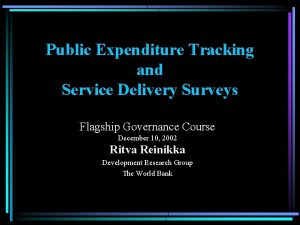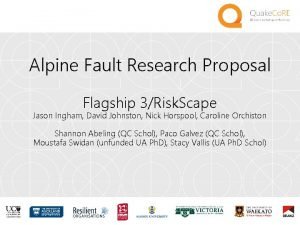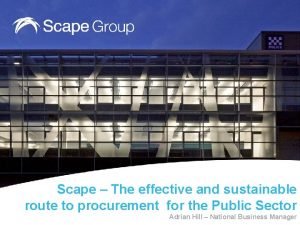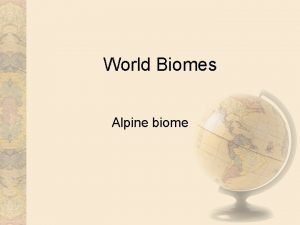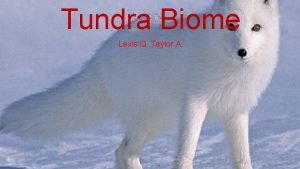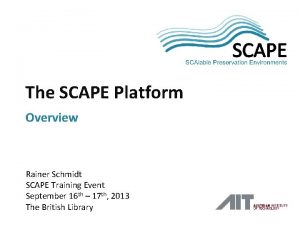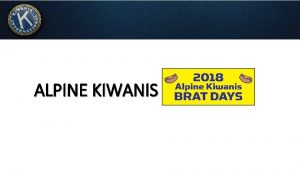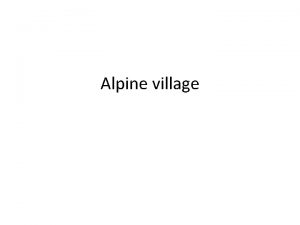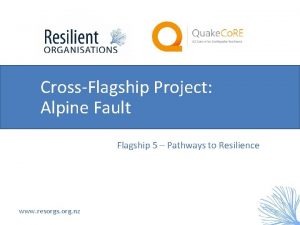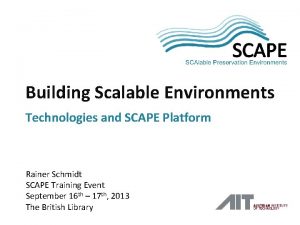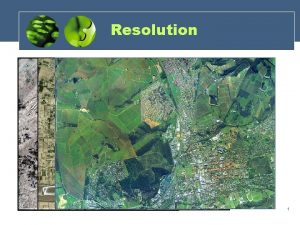Alpine Fault Research Proposal Flagship 3Risk Scape Jason








- Slides: 8

Alpine Fault Research Proposal Flagship 3/Risk. Scape Jason Ingham, David Johnston, Nick Horspool, Caroline Orchiston Shannon Abeling (QC Schol), Paco Galvez (QC Schol), Moustafa Swidan (unfunded UA Ph. D), Stacy Vallis (UA Ph. D Schol)

Prior to Kaikoura earthquakes Remote access data capture: Logic being that due to landslides etc it will be difficult to get access to West Coast for building/infrastructure inspections. Rely on locals for initial inspections • Drones used to limited extent in Christchurch. Technology has since greatly improved. • Opportunity to develop pre-programmed flight paths • Ensure ‘NZ Inc’ is aware and familiar with technology and opportunity • “Social media” can be effective method for data acquisition • Locals upload images of building/bridge/infrastructure to ‘data hub’ for remote critique and compilation to understand regional extent of damage • Not brought forward • Too “gimmicky”? Lacking ‘science excellence’? • Not used in Kaikoura earthquakes

Wellington? • Studies on taller multi-storey ‘complex buildings’ being undertaken within Flagship 4

Risk. Scape: Asset inventories, fragilities, and scenario studies for South Island rural industries (wineries and diary factories) • Significant influence on national economy. Opportunity to bring Ilan Noy into Alpine Fault work program • Significant unreported damage • High priority for ‘Risk. Scape team’ • Not brought forward: Not ‘buildings’. Not heritage. Concept was not favoured at last Alpine Fault team meeting

Two problems with applying ‘unadjusted’ Christchurch casualty data • Extensive earlier damage in Darfield earthquake when city was unoccupied • Many dangerous buildings were barracked in Feb 2011

Revised injury models • Casualty state = ground motion x damage states x %debris over building frontage x person present x casualty data • • • Building volume loss, failure modes, debris fall data Rhise casualty data set Risk. Scape casualty models Pedestrian model data Risk. Scape scenarios • New aspects: • • • Further value extracted from URM dataset Superior casualty models Inform CDEM efforts Improve Risk. Scape Inform socio-economic impacts

What town/city? • Simulations don’t clearly identify a location having large stock of vulnerable buildings • Nelson, Ashburton, Timaru, Oamaru, Queenstown, Dunedin, Invercargill, Greymouth • Branch faults? ‘Black swan events’?

Oamaru • Representative: Location, size, shaking • Distinct heritage precinct – align with Quake. Co. RE projects (Tourism, architecture) • Risk. Scape: • Full asset inventory of every building in Oamaru CBD • Specific application of building damage models • Application of casualty models • New aspects: • Superior scenario studies (Asset inventory, damage models, casualty models) • Effects of retrofitting on reduced casualties and damage • Potentially replicated to other locations? Dunedin? Queenstown?
